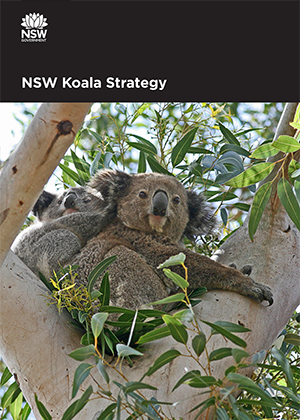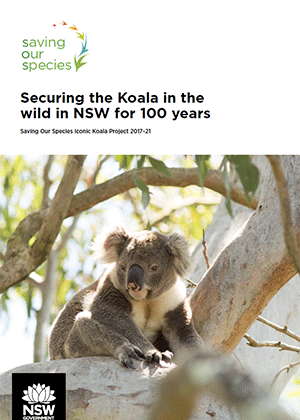What do they look like?
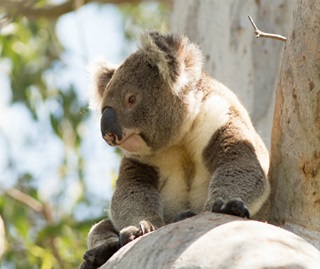 The koala is a tree-dwelling marsupial with large furry ears, a prominent black nose, long sharp claws adapted for climbing and no tail. Fur colour varies from pale grey in north Australia to grey-brown in the south.
The koala is a tree-dwelling marsupial with large furry ears, a prominent black nose, long sharp claws adapted for climbing and no tail. Fur colour varies from pale grey in north Australia to grey-brown in the south.
Koalas also vary in size across their range. Adult males weigh between 4 and 14 kilograms and adult females weigh between 4 and 10 kilograms.
Despite being called 'koala bears' for many years, koalas are marsupials. While bears give birth to well-developed young, newborn koalas are tiny enough to fit on your thumbnail, and are raised in their mother's pouch.
The closest relative of the koala is the wombat. Both animals have pouches which open towards the rear. This is fine for the wombat, but koalas need strong muscles ringing the pouch to keep their young from falling out.
Why are they special?
- Koalas are one of Australia's most iconic animals, recognisable around the world.
- People have a close affinity with the koala.
- Koalas feature in many Aboriginal dreaming and creation stories and are a totemic species.
- Koalas benefit the Australian economy. It has been estimated that they create over 9000 jobs and contribute between $1.1 billion and $2.5 billion per year to tourism in Australia.
- Although the koala’s Latin name, Phascolarctos cinereus, means ‘ash-coloured pouched bear,’ the koala is not a bear but a marsupial whose closest relative is the wombat.
- Koalas feed almost exclusively on eucalyptus leaves. The two or three primary tree species they prefer varies throughout their range. See the recent review of koala tree use across NSW.
Visit the NSW Koala Country website to find out how you can help koalas.












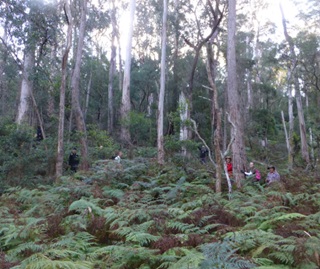
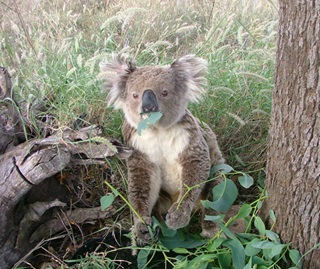 A koala eats about half a kilogram of leaves each day. Koalas are fussy eaters, choosing most of their food from a few varieties of eucalypt. Around Sydney, red gums and mahoganies are their favourites. In northern areas of the State, tallowwood and forest red gum are important, manna gum tops the bill in the south, and in the west koalas prefer river red gum and ribbon gum. They use a variety of other trees for shelter during the day and in heatwaves or storms, including paperbark, she-oak, brush box and acacia trees.
A koala eats about half a kilogram of leaves each day. Koalas are fussy eaters, choosing most of their food from a few varieties of eucalypt. Around Sydney, red gums and mahoganies are their favourites. In northern areas of the State, tallowwood and forest red gum are important, manna gum tops the bill in the south, and in the west koalas prefer river red gum and ribbon gum. They use a variety of other trees for shelter during the day and in heatwaves or storms, including paperbark, she-oak, brush box and acacia trees.
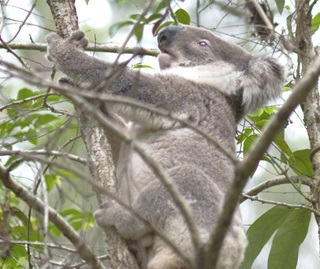 With huge claws and strong muscles, koalas are able to hold on tightly to trees. They have two thumbs and three fingers on each front paw, which makes their grip more even on each side of a branch.
With huge claws and strong muscles, koalas are able to hold on tightly to trees. They have two thumbs and three fingers on each front paw, which makes their grip more even on each side of a branch. 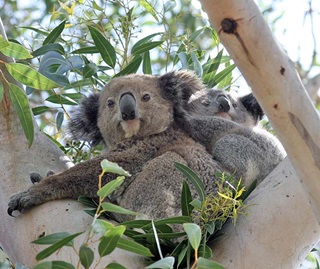 Koalas live for between 10 and 20 years, and generally breed between September and February. Female koalas can breed from about 2 years of age, and have a gestation period of about two month, producing one koala a year. On rare occasions they may produce twins.
Koalas live for between 10 and 20 years, and generally breed between September and February. Female koalas can breed from about 2 years of age, and have a gestation period of about two month, producing one koala a year. On rare occasions they may produce twins.
